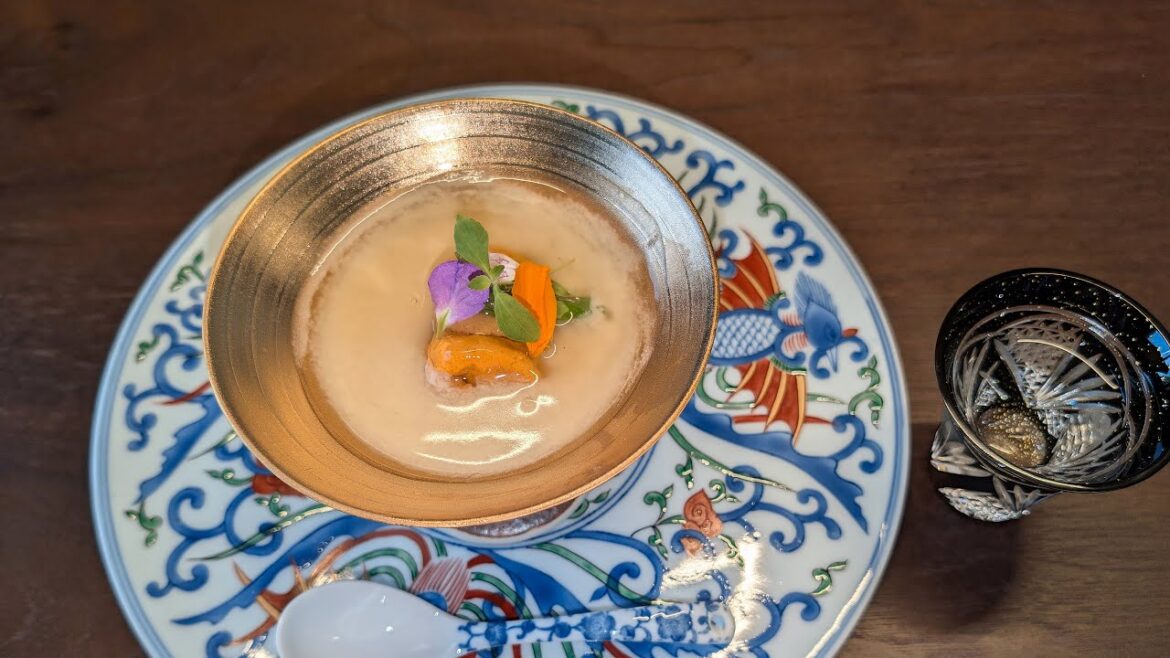Heda, Numazu, Shizuoka (静岡県沼津市戸田) – Dinner at Fuji Seiran ryokan (富士青藍) 2025 May 25
We were served a spectacular Japanese dinner at Fuji Seiran (富士青藍), a newly opened 5-room luxury onsen ryokan with stunning views of Mt. Fuji (when it’s visible) across the Suruga Bay in Heda, Numazu, Izu Peninsula, Shizuoka Prefecture (静岡県伊豆半島沼津市戸田.) The property had just commenced its grand opening three days before our visit, and we were the only guests when we stayed here.
The menu, as well as explanation of each serving, were in Japanese, but I’ve tried my best to summarize everything in both languages here:
COURSE 1 – SAKIZUKE (先附 – Appetizers):
* Fuji no Sakura Tamago no Chawanmushi (富士の桜卵の茶碗蒸し –
* White Asparagus no Puree to Nama Uni (ホワイトアスパラガスのピューレと生雲丹 –
* Green Asparagus (グリーンアスパラガス)
* Gyokai dashi ankake (魚介出汁餡掛け – Seafood dashi ankake)
COURSE 2 – ZENSAI (前菜 – Appetizers #2):
* Mushi Awabi, Kimo sauce (蒸し鮑, 肝ソース)
* Izunokuni Shiitake to Kani no Hutami-yaki (伊豆の国椎茸と蟹の二見焼き – Shiitake from Izunokuni and Crab grilled with Wasabi Miso)
* Foie Gras to Oohito-san Takenoko no Hasami-age (フォアグラと大仁産筍の挟み揚げ – Battered and deep-fried Bamboo Shoots from Oohito with Foie Gras sandwiched inside)
– Sakura-ebi powder (桜海老パウダー – )
* Hisui Tofu (翡翠豆腐 – ) Horsenso and Edamame Paste with Kuzu o soete
* Suruga Wan-san Akaza-ebi to Caviar to Shuzenji-san Soramame no Kimizu-gake (駿河湾産赤座海老とキャビアと修善寺産空豆の黄身酢掛け – )
COURSE 3 – WANMONO (椀物 – Soup Dish):
* Katsuo dashi no Osumashi (鰹出汁のおすまし – Clear soup made from dashi stock from bonito flakes and kelp)
– Suruga Wan-san Amadai to Hotate Shinjo (駿河湾産甘鯛と帆立真薯 – Horsehead fish wrapped with Scallop paste inside)
– Kuchi Yuzu (口柚子 – Yuzu Japanese citrus)
– Hana Zucchini (花ズッキーニ – Zucchini flowers)
– Myoga (茗荷 – Japanese ginger)
COURSE 4 – OTSUKURI (御造り – Sashimi):
* Hon Maguro (本鮪 – Bluefin Tuna)
* Kue (九会 – Longtooth Grouper)
* Kinmedai (金目鯛 – Splendid Alfonso)
* Aori Ika (煽烏賊 – Bigfin Reef Squid)
* Toi-san Wasabi to Heda-jio (土肥産山葵と戸田塩 – Wasabi from Toi and Salt from Heda, both in Shizuoka Prefecture’s Izu Peninsula)
COURSE 5 – SAKANA RYORI (魚料理 – Fish Dish):
* Nishi Izu Tago-san Ise-ebi no Gusoku-ni (西伊豆田子産伊勢海老の具足煮 – Ise Spiny Lobster sliced with the shells still attached and then boiled. From Tago in West Izu Peninsula)
– Kabu (蕪 – Japanese turnip)
– Green Cherry Tomato (グリーンチェリートマト)
– Red Cherry Tomato (チェリートマト)
– Snap Endo (スナップエンドウ – Snap Peas)
– Young Corn (ヤングコーン)
COURSE 6 – NIKU RYORI (肉料理 – Meat Dish):
FOR HIM AND HER MOTHER:
* Shizuoka Ken-san Kuroge Wagyu “Shizuoka Sodachi” Chojo Filet Steak (静岡県産和牛 “静岡そだち” 頂上フィレステーキ – “Shizuoka Sodaki”-branded Kuroge Wagyu beef filet steak that’s been roasted at 58 degrees Celsius for 2 hours.)
– Kuro Truffle Sauce (黒トリュフソース – Black Truffle Sauce)
FOR HER:
* Hamamatsu Unagi Shirayaki (浜松産鰻白焼き – Eel from Hamamatsu in Shizuoka Prefecture. Shirayaki refers to a cooking method in which the Eel is grilled directly over a fire without adding any other additives such as seasonings, sauces or oils during the grilling process.)
– Sansho sauce (山椒ソース – Sansho pepper sauce)
– Wasabi (山葵)
– Paprika (パプリカ)
– Zucchini (ズッキーニ)
– Eringi (エリンギ – Eringi Mushrooms)
– Satsuma-imo (薩摩芋 – Japanese sweet potato)
– Nobiru (のびる – Nobiru is known as Wild Rocambole, and is a Japanese wild plant that’s somewhat similar to field garlic or a long onion)
COURSE 7 – OSHOKUJI (Rice Dish):
* Akita Ken-san Sakihokore Kobu-dake (Steamed “Sakihokore”-brand rice from Akita Prefecture cooked with Konbu Sea Kelp in a Donabe clay pot)
* Omaezaki-san Hatsu zuke-Gatsuo (御前崎産初鰹 – Lightly-seared New season Bonito from Omaezaki in Shizuoka Prefecture)
– Negi (葱 – Spring Onions)
– Myoga (茗荷 – Japanese ginger)
– Fried garlic (フライドガーリック)
* Omaezaki-san Hatsu Gatsuo to Shoga no Dashi Chazuke Hu (御前崎産初鰹と生姜の出汁茶漬け風 – New season Bonito from Omaezaki in Shizuoka Prefecture and Ginger broth that is intended to be added later to rice to make Dashi Chazuke)
* Kounomono (香の物 – Pickled Vegetables)
– Iburi Gakko (いぶりがっこ – Smoked and pickled Daikon radish)
– Wasabi Kuki (山葵茎 – Pickled Wasabi stems)
COURSE 8 – DESSERT (デザート):
* Hiyashi Zenzai (冷やしぜんざい – Chilled Zenzai, which is a Japanese sweet made by boiling sweet red beans, adding sugar and adding Mochi or Shiratama, among other items)
– Cut Fruits (カットフルーツ):
– Beni Hoppe Ichigo (紅ほっぺ苺 – Beni Hoppe-brand Strawberries)
– Shizuoka Melon (静岡メロン – Melon from Shizuoka Prefecture)
– Blueberry (ブルーベリー)
– Orange (オレンジ)
– Shiratama (白玉 – Shiratama is a Japanese “dango” dumpling made from rice flour mixed with uruchi rice flour and glutinous rice flour. It is different from the method of making mochi, which is made after steaming glutinous rice)
– Shiro An no Espuma (白餡のエスプーマ – Sweet White Bean Paste cream)
– Pistachio no Ice (ピスタチオのアイス – Pistachio Ice Cream)
– Ginger Ale soup (ジンジャーエールスープ)
COURSE 9 – KOGASHI (小菓子 – Small Sweets):
* Canele (カヌレ)
* Chiffon Cake (シフォンケーキ)
* Orangette (オランジェット – A French dessert made by frozen sugar pickled orange pieces dipped in chocolate)


AloJapan.com